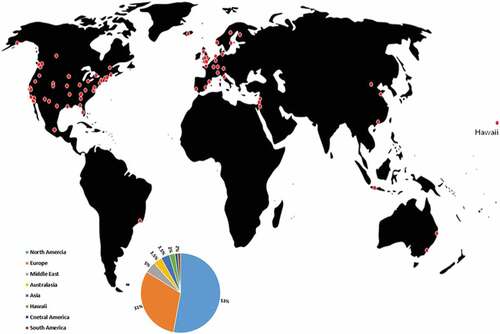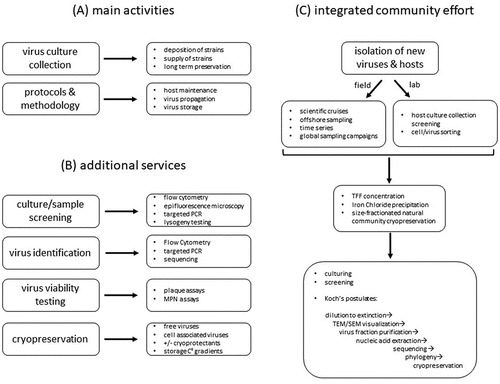Figures & data
Table 1. A subset of some of the private aquatic virus culture collections and the host species that these virus isolates infect. Note that the list is partial and does not represent a comprehensive summary of all the different aquatic viruses currently in culture or all the different institutions that engage in aquatic algal and/or bacterial research. Rather, it emphasises that there are many aquatic virus isolates within the research community, but not in a centralised, purposely - orientated depository. The information in this table was supplied by colleagues and our current knowledge of where some of the work is currently being done.
Figure 1. The aquatic virus ecology is a widespread, global research field. Although this map is not inclusive of all the research groups and institutions engaged in aquatic virology and ecology, the red dots represent a subset of geographical locations (pie chart) where some institutions and researchers engaged in aquatic algal-virus and/or aquatic bacterial-virus research are located. The figure was adapted and modified from the “collaboration map” within the VERVENet platform (www.protocols.io/groups/verve-net), with additional information added based on our current knowledge of where some of the research is presently done.

Table 2. A potential virus information sheet at an AVCC should provide information to users about the viruses within the collection and their host organism. Initial details should be provided by the depositors of the viral strains with as much information as possible, while adhering to the taxonomic guidelines of The International Committee on Taxonomy of Viruses (ICTV). Note that the accompanying information listed under the host organism is not as detailed as that usually provided by an existing algal or bacterial culture collection. This information (and the extent to which it goes into detail) may vary depending on the type of information available to the AVCC about the specific host organism.
Figure 2. Schematic representation of the type of services an Aquatic Virus Culture Collection (AVCC) may be able to provide, and a road map for the isolation of novel host-virus model systems. (A) Main services are predominantly deposition and supply of viral strains and their long term preservation in culture or a cryopreserved state. (B) Additional services which will allow for the collection to be financially sustainable include sample screening for viruses, identification of viruses, viability testing and optimisation of cryopreservation methods. (C) The road map for isolating novel hosts and their viruses from aquatic include field- and lab based approaches with the ultimate goal being fulfilment of Koch’s postulates of new viruses and their hosts, and their subsequent long term preservation at the AVCC.

